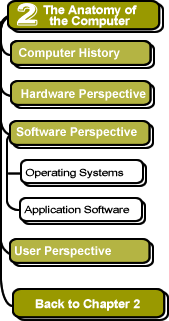
|
|
Lesson 3: Software Perspective
Earlier we said that software is simply a set of instructions that tell the hardware what to do. It is written in a language that computers understand, where the "letters" are 1s and 0s that make up the individual instructions that form the software programs stored on hard drives or in the main memory of the computer.
Software can usually be divided into:
- operating system
software - The operating system is the software that administrates
the computer.The operating system is usually responsible for running
the computer when you first turn it on, letting users log in to the computer
(possibly with a username and password), organizing information on the
computer (often using a directory of files), shutting the computer off
gracefully, and giving the user a way to run and manage other programs
on the computer (often using a graphical interface). Popular operating
systems include the Microsoft Windows family of operating systems (such
as Windows 3.1 and Windows XP), the Apple
computer operating systems (such as OS X), and many variations on the
UNIX operating system (such as Linux and Sun Solaris). Note:
for more detailed information on operating systems, please see the Operating
Systems tutorial.

- application software - Application software lets you complete a task on the computer and includes word processors, spreadsheets, and databases. Popular application software includes the Microsoft Office suite of software: Word, Excel, PowerPoint, and Access. Note: for more detailed information on application systems please see the RIT Tutorials
Let's look at both in more detail.
![]()
![]()
These pages were written by Steven H. VanderLeest and Jeffrey Nyhoff and edited by Nancy Zylstra
©2005 Calvin University (formerly Calvin College), All Rights Reserved
If you encounter technical errors, contact computing@calvin.edu.
